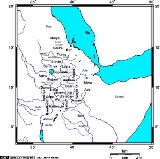
Amda Seyon I
Overview
Amda Seyon was Emperor of Ethiopia
(1314–1344; throne name Gebre Mesqel Ge'ez ገብረ ፡ መስቀል gabra masḳal, Amh. gebre mesḳel, "slave of the cross
"), and a member of the Solomonic dynasty
. According to the British expert on Ethiopia, Edward Ullendorff
, "Amde Tseyon was one of the most outstanding Ethiopian kings of any age and a singular figure dominating the Horn of Africa
in the fourteenth century." His conquests of Muslim borderlands greatly expanded Ethiopian territory and power in the region, maintained for centuries after his death.
Emperor of Ethiopia
The Emperor of Ethiopia was the hereditary ruler of Ethiopia until the abolition of the monarchy in 1974. The Emperor was the head of state and head of government, with ultimate executive, judicial and legislative power in that country...
(1314–1344; throne name Gebre Mesqel Ge'ez ገብረ ፡ መስቀል gabra masḳal, Amh. gebre mesḳel, "slave of the cross
Christian cross
The Christian cross, seen as a representation of the instrument of the crucifixion of Jesus Christ, is the best-known religious symbol of Christianity...
"), and a member of the Solomonic dynasty
Solomonic dynasty
The Solomonic dynasty is the Imperial House of Abyssinia. Its members claim lineal descent from King Solomon and the Queen of Sheba, the latter of whom tradition asserts gave birth to the first King Menelik I after her Biblically described visit to Solomon in Jerusalem .-Overview:The dynasty, a...
. According to the British expert on Ethiopia, Edward Ullendorff
Edward Ullendorff
Edward Ullendorff FBA was a British scholar and historian, especially in Semitic languages and Ethiopia.-Biography:...
, "Amde Tseyon was one of the most outstanding Ethiopian kings of any age and a singular figure dominating the Horn of Africa
Horn of Africa
The Horn of Africa is a peninsula in East Africa that juts hundreds of kilometers into the Arabian Sea and lies along the southern side of the Gulf of Aden. It is the easternmost projection of the African continent...
in the fourteenth century." His conquests of Muslim borderlands greatly expanded Ethiopian territory and power in the region, maintained for centuries after his death.
Unanswered Questions

